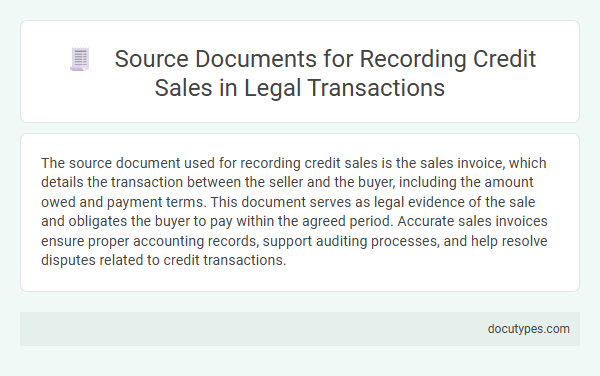The source document used for recording credit sales is the sales invoice, which details the transaction between the seller and the buyer, including the amount owed and payment terms. This document serves as legal evidence of the sale and obligates the buyer to pay within the agreed period. Accurate sales invoices ensure proper accounting records, support auditing processes, and help resolve disputes related to credit transactions.
Introduction to Source Documents in Credit Sales
Source documents are essential records used in accounting to accurately track credit sales. These documents provide the foundational evidence needed for recording financial transactions and maintaining legal compliance.
- Invoice - A detailed bill issued to a customer outlining the products or services sold on credit and the payment terms.
- Sales Order - A confirmation document generated when a customer places an order, serving as a preliminary record before invoicing.
- Delivery Note - A document that accompanies the delivery of goods, verifying the shipment details associated with the credit sale.
Your use of proper source documents ensures transparency and accuracy in credit sales accounting.
Legal Importance of Source Documents
The source document used for recording credit sales is typically the sales invoice. This document provides detailed proof of the transaction and serves as a legal record for both parties involved.
Source documents hold significant legal importance as they establish the authenticity and terms of credit sales. They support accurate financial reporting and help resolve disputes by offering verifiable evidence. You should ensure that all credit sales are backed by properly maintained source documents to protect your business interests.
Types of Source Documents for Credit Sales
Source documents for recording credit sales are essential records that provide proof of the transaction between the seller and the buyer. Common types include sales invoices, which detail the goods or services sold along with payment terms, and sales orders, which confirm the buyer's request. Your business relies on these documents to ensure accurate financial reporting and legal compliance in accounting for credit sales.
Sales Invoices: Structure and Legal Requirements
The source document used for recording credit sales is the sales invoice. This document serves as proof of the transaction and details the goods or services provided on credit.
Sales invoices must contain specific information to meet legal requirements, including the seller's and buyer's details, invoice date, a unique invoice number, description of goods or services, quantity, unit price, and total amount. Your compliance with these standards ensures accurate financial records and legal validity in credit sales transactions.
Credit Notes and Their Legal Significance
Source documents for recording credit sales primarily include sales invoices and credit notes. Credit notes serve as official records issued when goods are returned or discounts are applied, adjusting the original credit sales amount.
Credit notes carry significant legal weight as they provide evidence for transaction amendments between buyers and sellers. They ensure transparency, support accurate accounting records, and protect both parties in disputes or audits.
Delivery Orders and Proof of Transfer
What is the source document used for recording credit sales? Delivery orders serve as the primary source document, detailing the transfer of goods from the seller to the buyer on credit. Proof of transfer further substantiates the transaction, ensuring accurate recording and legal compliance in your accounting records.
Contracts and Agreements in Credit Sales
The source document used for recording credit sales is the sales contract or credit agreement, which outlines the terms and conditions between the buyer and seller. This document specifies the credit period, payment schedule, and obligations of both parties, ensuring legal clarity and enforceability. Proper documentation through contracts is essential for accurate accounting and protecting the interests of businesses in credit transactions.
Role of Receipts in Legal Documentation
| Aspect | Details |
|---|---|
| Source Document for Recording Credit Sales | Invoices and sales receipts serve as primary source documents for recording credit sales. These documents provide detailed information about the transaction, including the parties involved, the goods or services sold, quantity, price, and terms of payment. |
| Role of Receipts in Legal Documentation | Receipts act as formal proof of a transaction and document acceptance of goods or services by the buyer. In the context of credit sales, receipts verify that a sale has occurred and support the seller's claim for payment. They are essential in resolving disputes, providing evidence of delivery, and substantiating financial records for legal compliance. |
| Legal Importance | Receipts and invoices are recognized legal documents that support enforcement of contracts and claims in courts. They establish a timeline of transactions and confirm mutually agreed terms, reducing ambiguity in credit arrangements. Proper maintenance of these documents aids in audit processes and regulatory adherence. |
Electronic Source Documents and Legal Compliance
Electronic source documents serve as the primary evidence for recording credit sales, ensuring accuracy and traceability in financial transactions. Proper use of these digital records supports your business's legal compliance by maintaining secure and verifiable audit trails.
- Definition of Electronic Source Documents - Digital records such as electronic invoices, receipts, and sales orders that capture details of credit sales transactions.
- Role in Legal Compliance - These documents comply with regulatory standards for record-keeping, providing proof to tax authorities and auditors.
- Security and Integrity - Electronic source documents must be protected against unauthorized access and tampering to uphold their validity as legal evidence.
What Is the Source Document Used for Recording Credit Sales? Infographic

